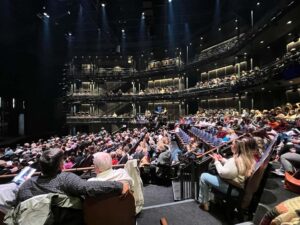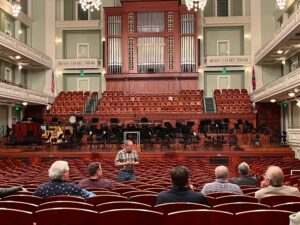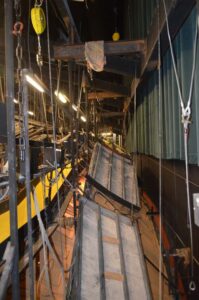100 Things a Theatre Architect Should Experience

The audience anticipates the start of a show, The Yard at Chicago Shakespeare Theater, 2022. Photo by Paul Sanow, ASTC.
The following writing is inspired by Michael Sorkin’s Two Hundred Fifty Things an Architect Should Know. Michael was “one of architecture’s most outspoken public intellectuals, a polymath whose prodigious output of essays, lectures and designs, all promoting social justice, established him as the political conscience in the field,” according to his New York Times obituary.
Sorkin’s original work can be found online here: https://www.readingdesign.org/250-things and it is worth a read. It’s quite enjoyable. Some of the ideas below are borrowed from this list, and where directly quoted they are in italics.
Michael’s writing inspired this list, but narrows the focus to things which are important to understand in relation to the performing arts.

ASTC members hear about Laura Turner Concert Hall at Schermerhorn Symphony Center, Nashville, 2022. Photo by Paul Sanow, ASTC.
- Go to the theatre often.
- …Count everything. People in lines, numbers of entrances, trucks in the back, busses at the front, performers on stage …Everything.
- Measure everything. Doors, rows, prosceniums, seats, bars . . . Everything.
- Read a script and then see it performed.
- …Have a heated discussion about Godot.
- Know the rules of improv.
- Ask over and over why IS it always done that way.
- Embrace gallows humour.
- Break the fourth wall.
- Sit in an empty theatre by yourself.
- …in a packed house.
- …in a poorly attended show.
- Sitting in an audience ask yourself if you feel connected.
- …to the performers on stage.
- …to other patrons
- …How does this change from venue to venue
- Watch the audience during a show… but don’t be creepy about it.
- Look for how dark the theatre actually was when the performance relied on darkness.
- Experience trying to find your seat in the dark.
- Learn how to listen closely.
- Listen to the theatre building.
- …and to the patrons throughout a show.
- …for how silent the theatre actually was when the performance relied on silence.
- …for the cadence skip when a phone rings.
- What it’s like to sit in a high-quality theatre seat for 3 hours…now a Cheap seat.
- What it’s like to watch a show from the front row.
- …From the rear of the room.
- …From the front of the balcony.
- …From the nosebleed seats.
- Sit at the end seat of a continental seating row…and in the middle.
- Sit in a row with too little row space.
- …with too much row space.
- Buy tickets for a family group that includes one person with a disability.
- …attend the show.
- Understand accessibility issues in a room full of steps.
- Find the right auditorium temperature for everyone (a fool’s errand).
- Study the distance at which you can recognize faces.
- … and how sightlines work.
- Trigonometry and Geometry.
- Experience how bad seating or sightlines can wreck an otherwise perfect performance.
- Know that the art made here evolves more rapidly than the building.
- …Be a part of this art.
- Embrace the depths of desire.
- … and the heights of folly.
- In is down, out is up.
- Stage left is the left as you face the audience when on stage.
- …House right is on the same side.
- Imagine that the stage is raked, Upstage is the rear of the stage.
- …Downstage is the front.
- Work on a show as a stagehand or designer.
- Participate in a week of tech rehearsals.
- Watch a load in or load out.
- Understand that the future of a theatre arrives in a truck.
- Learn how to play a musical instrument.
- Perform in a show or join a choir.
- Work in a theatre until past midnight.
- …and then again at 8am the next morning.
- Operate a follow spot.
- Understand what dimming to 0 means.
- Load counterweight.
- …Get your finger pinched.
- Make mistakes gracefully and own them completely.
- Climb a long straight ladder.
- Stand on top of a fly tower.
- Shadow a stage manager in rehearsal.
- …During a performance.
- See a film or concert in a theatre you’ve seen a play in.
- …how is it different.
- Attend a show for young performers.
- …Performed by young performers.
- …that includes a dog.
- See a show in another language.
- …From another culture.
- See a show in a proscenium theatre.
- …in a thrust theatre.
- …in the round.
- …in an amphitheatre
- …notice the difference.
- Go to previews and hope the show needs to stop and reset.
- Experience the foyer before the show.
- …During the show.
- …At intermission.
- …After the show.
- …When there is no show.
- Chat with the ushers.
- …ask if a patron has died during a performance.
- Study how people pee . . . Don’t be creepy about it.
- Use an all-gender washroom.
- Stand in a long line for the bathroom.
- …then hope the bar line is short.
- …decide what you’re having before you get to the front!
- Understand how people drink and eat while standing.
- Embrace curiosity.
- Understand why we build theatres anyway.
- …and what the client for this theatre wants.
- …actually needs.
- …can afford.
- Understand what the planet can afford.
- Understand that the design team is building an instrument that the owner will be tuning forever.
- Know that you’re only as good as your last show (or building)
(For best results, hire a Theatre Consultant.)
By Jim Hultquist, ASTC
Disclaimer: Any views or opinions expressed in this article are solely those of the author and do not necessarily represent those of the American Society of Theatre Consultants. This article is for general information only and should not be substituted for specific advice from a Theatre Consultant, Code Consultant, or Design Professional, and may not be suitable for all situations nor in all locations.




